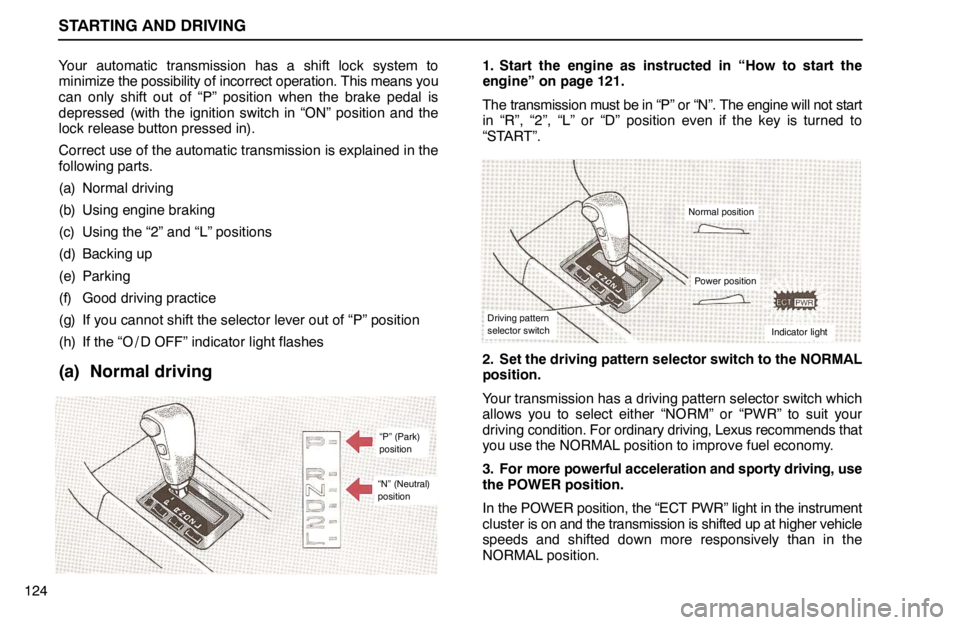ESP lexus LS400 1994 Engine / 1994 LS400: STARTING AND DRIVING
[x] Cancel search | Manufacturer: LEXUS, Model Year: 1994, Model line: LS400, Model: Lexus LS400 1994Pages: 21, PDF Size: 2.83 MB
Page 8 of 21

STARTING AND DRIVING
124Your automatic transmission has a shift lock system to
minimize the possibility of incorrect operation. This means you
can only shift out of “P” position when the brake pedal is
depressed (with the ignition switch in “ON” position and the
lock release button pressed in).
Correct use of the automatic transmission is explained in the
following parts.
(a) Normal driving
(b) Using engine braking
(c) Using the “2” and “L” positions
(d) Backing up
(e) Parking
(f) Good driving practice
(g) If you cannot shift the selector lever out of “P” position
(h) If the “O / D OFF” indicator light flashes
(a) Normal driving
“P” (Park)
position
“N” (Neutral)
position
1. Start the engine as instructed in “How to start the
engine” on page 121.
The transmission must be in “P” or “N”. The engine will not start
in “R”, “2”, “L” or “D” position even if the key is turned to
“START”.
Driving pattern
selector switchIndicator light
Power position
Normal position
2. Set the driving pattern selector switch to the NORMAL
position.
Your transmission has a driving pattern selector switch which
allows you to select either “NORM” or “PWR” to suit your
driving condition. For ordinary driving, Lexus recommends that
you use the NORMAL position to improve fuel economy.
3. For more powerful acceleration and sporty driving, use
the POWER position.
In the POWER position, the “ECT PWR” light in the instrument
cluster is on and the transmission is shifted up at higher vehicle
speeds and shifted down more responsively than in the
NORMAL position.
Page 15 of 21

STARTING AND DRIVING
131
LEXUS RIDE CONTROL SYSTEM
(U. S. A. ONLY)
The Lexus ride control system adjusts the damping effect
on the shock absorbers. This adjustment is automatically
made in response to the driving conditions to provide
good riding comfort and stability in all driving conditions.
Push the selector switch to select one of the following modes:
“NORMAL” mode − For normal driving such as in city traffic
“SPORT” mode − For sporty type driving such as on winding
mountain roads, or high-speed driving
To change the mode, push the selector switch.“NORMAL” mode
One of the following three damping effects is automatically
selected according to the driving conditions:
Damping effect
Driving condition
SoftLow and medium speed driving
MediumHigh-speed driving
FirmDriving in a curve
Braking in high-speed driving
Sudden acceleration in low-
speed driving
“SPORT” mode
The damping effect remains at firm at all driving conditions.
Page 16 of 21

STARTING AND DRIVING
132
The indicator light shows the selector switch is in
“SPORT” position. When the indicator light is not on, this
means the selector switch is in “NORMAL” position.
When you turn the ignition key to the “ON” position, the
indicator lights will come on for two seconds.
HEIGHT CONTROL SYSTEM
(U. S. A. ONLY)
The height control system adjusts the vehicle height. This
adjustment is automatically made in response to the
driving conditions to provide good riding comfort and
stability in all driving conditions.
(a) Vehicle height adjustment
Push the selector switch to select one of the following modes:
“NORMAL” mode − For driving on roads with a normal
surface.
“HIGH” mode − For driving on rough roads which are
unsurfaced or continually bumpy.
To change the mode, push the selector switch.
“NORMAL” mode
The vehicle height remains at normal height at all driving
speeds.